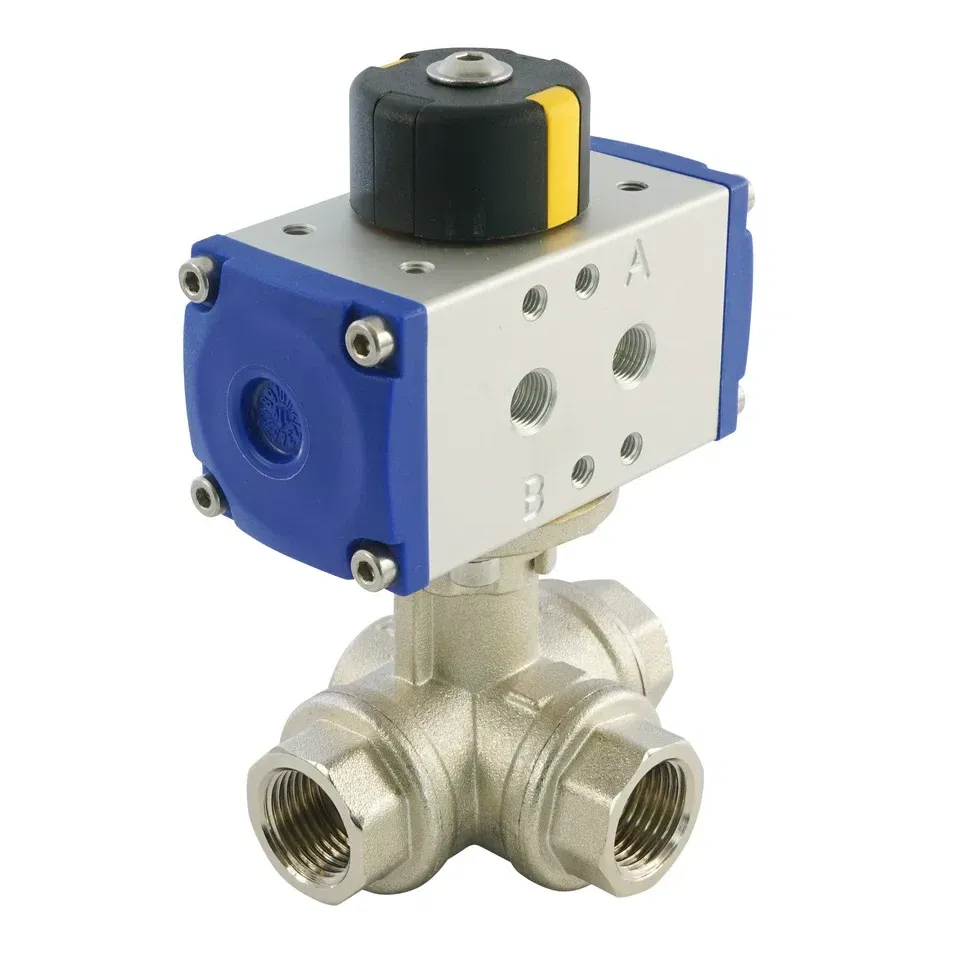
In modern industrial systems, automation plays a crucial role in enhancing efficiency and precision. One key component in fluid control systems is the 3-way pneumatic ball control valve (L-port), designed to provide seamless operation for liquid and gas flow management. Compared to manually operated valves, this pneumatically controlled model significantly boosts automation and ease of operation.
This 3-way ball control valve features a 10 mm diameter and is suitable for use with both liquids and gases within a temperature range of -10°C to 100°C. The pneumatic actuator generates a robust 9.92 Nm torque at 8 bar, with an adjustable control pressure range of 6 to 10 bar, ensuring reliable operation across various industrial applications.
The valve body is constructed from brass, ensuring durability and corrosion resistance, while the PTFE seal enhances longevity and leak prevention. It supports a maximum media pressure of 40 bar, making it suitable for demanding environments. The valve has G 3/8-inch threads for secure piping or hose connections and a Kv value of 3 m³/h, indicating efficient flow control.
The actuator operates on a double-acting mechanism, providing superior control over fluid flow. It utilizes a rack-and-pinion rotational system with an anodized aluminum housing for durability and an acetal resin cover for added protection. The actuator is equipped with G1/8 ports for air supply and return, facilitating smooth and responsive operation.
For streamlined control, it is recommended to mount a 1/4-inch Namur solenoid valve directly onto the actuator. This configuration minimizes additional fittings and tubing, optimizing the installation process. It is important to note that 1/4-inch refers to the Namur size, not the port size. Additionally, the actuator can accommodate a position control or limit switch box, aligning with VDI/VDE 3845 standards for enhanced monitoring capabilities.
The ISO 5211 F03 flange (9 mm) allows for secure and standardized mounting between the actuator and the ball valve, ensuring compatibility with various systems. Furthermore, the entire assembly is ATEX certified (EX II 2GD c), making it suitable for use in potentially explosive environments, an essential feature for industries dealing with hazardous materials.
This pneumatic ball valve system provides several key advantages:
The ability to directly mount a Namur solenoid valve reduces the need for additional fittings and tubing, simplifying the setup.
A mechanical indicator on the top of the actuator provides a visual representation of the valve’s position, improving monitoring and control.
Its EX II 2GD c certification ensures safe operation in explosive environments, making it a preferred choice for industries dealing with volatile substances.
Compared to electric actuators, this pneumatic system offers a more cost-effective solution while maintaining high-performance standards.
The double-acting mechanism ensures rapid opening and closing, improving overall system efficiency.
Unlike single-acting actuators, the double-acting design provides precise and reliable flow regulation.
For enhanced monitoring and control, a limit switch box can be integrated into the system.
Despite its advantages, the 3-way pneumatic ball valve has some limitations to consider:
The double-acting actuator consumes more compressed air compared to a single-acting alternative.
A dedicated air supply and solenoid valve are necessary for operation, which may add to the system's complexity.
While the initial investment cost is lower, pneumatic actuators tend to have higher energy consumption than electric alternatives.
Begin by cutting the pipeline at the desired installation point using a pipe cutter, ensuring the cut is clean and even. Next, connect the valve body to the pipeline based on the piping type—threaded, flanged, or welded. Apply a suitable sealant or gasket to prevent leaks. Secure the valve body by tightening the connections with a wrench, but avoid over-tightening, as this could damage the valve.
Align the pneumatic actuator with the valve body’s stem to ensure proper positioning. Once aligned, secure the actuator to the valve body using the provided bolts or clamps. Connect the actuator to the air supply piping, ensuring the air pressure meets the actuator’s specifications.
Conduct a manual test by operating the valve using the actuator’s manual override (if available) to confirm smooth opening and closing. Next, perform a pneumatic test by activating the air supply to verify that the actuator drives the valve correctly. Finally, pressurize the system and inspect the valve and connections for any leaks, ensuring a secure and leak-free installation.
By following these steps, you can ensure proper installation and functionality of the pneumatic ball control valve.
The 3-way pneumatic ball control valve is an excellent solution for industries requiring precise, automated flow control with the ability to handle high-pressure and hazardous environments. Its robust design, ATEX certification, and cost-effectiveness make it a valuable addition to various industrial applications. However, potential users should weigh the air consumption and infrastructure requirements when selecting this valve for their systems.
By integrating this reliable and efficient pneumatic valve, industries can enhance automation, improve safety, and optimize fluid control processes with confidence.